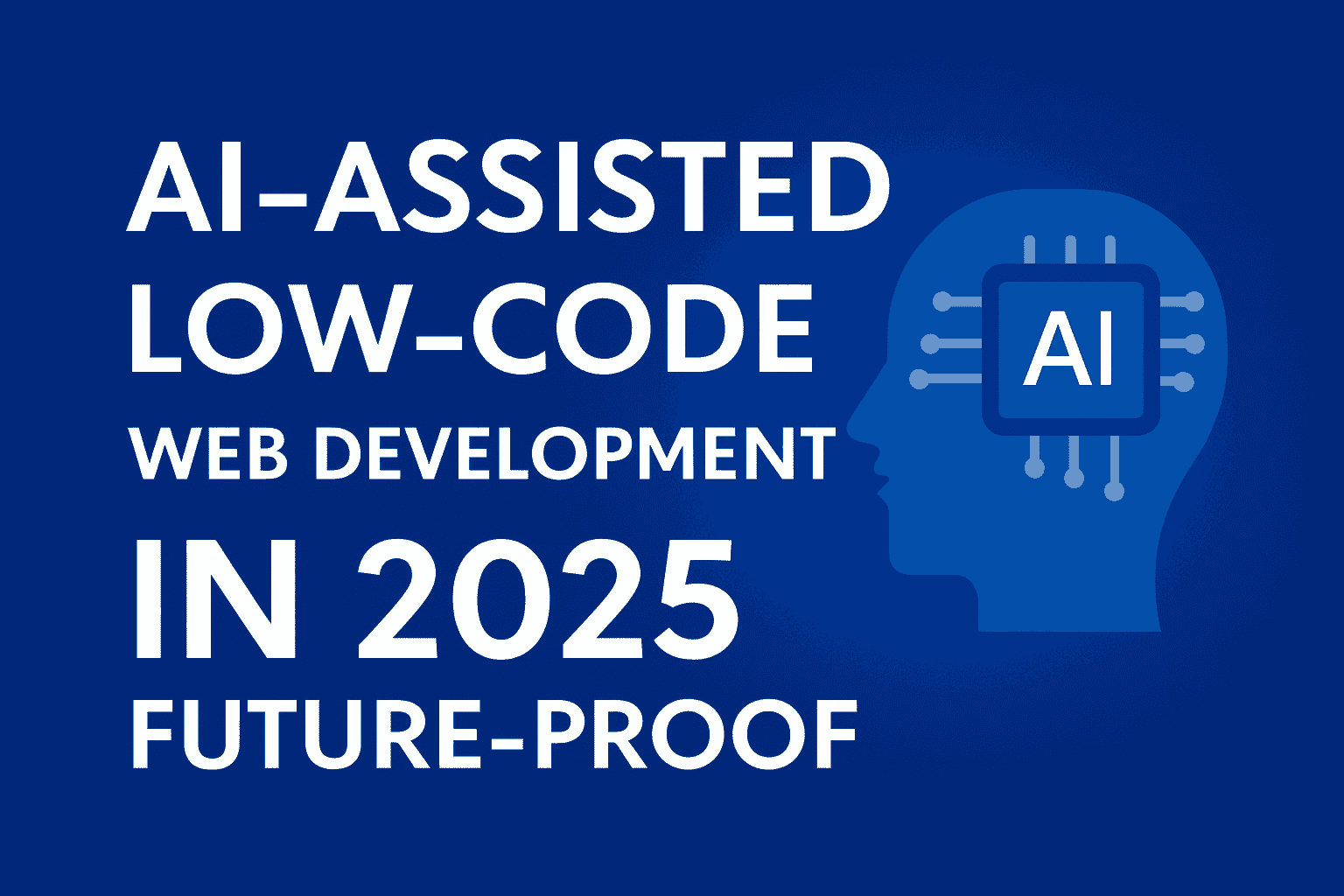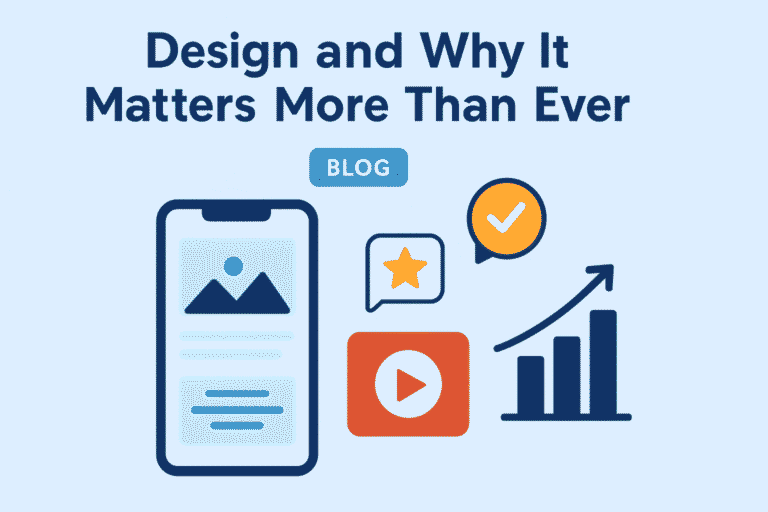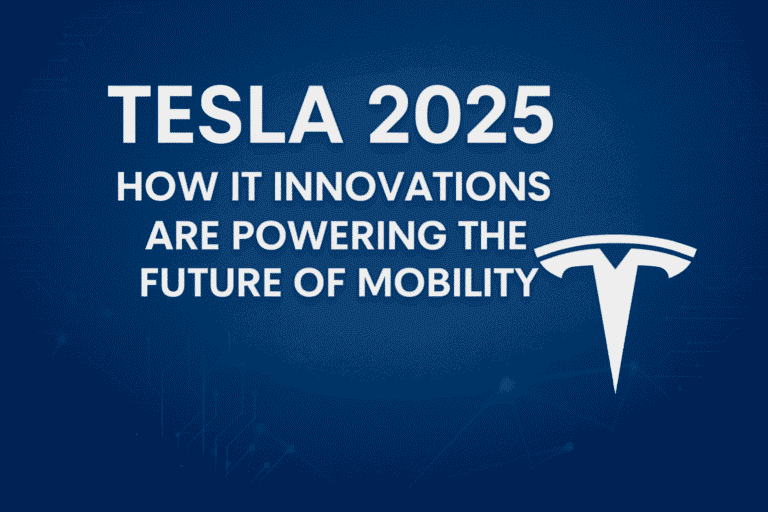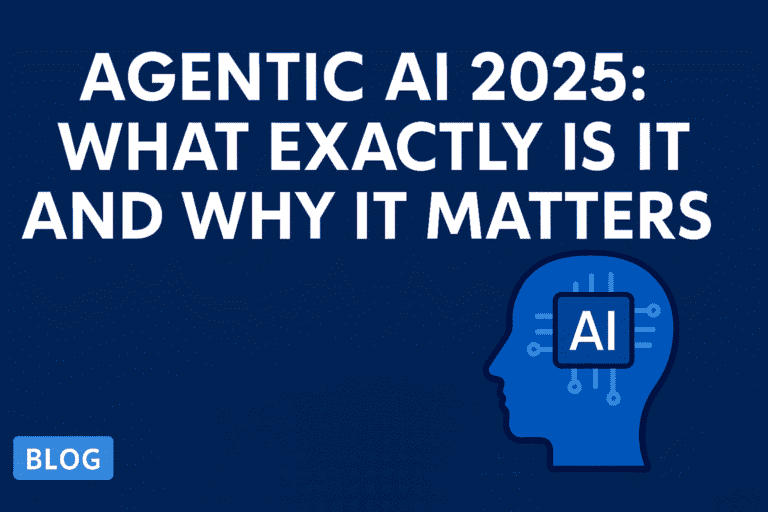AI-Assisted Low-Code Web Development Services for Small Businesses in 2025
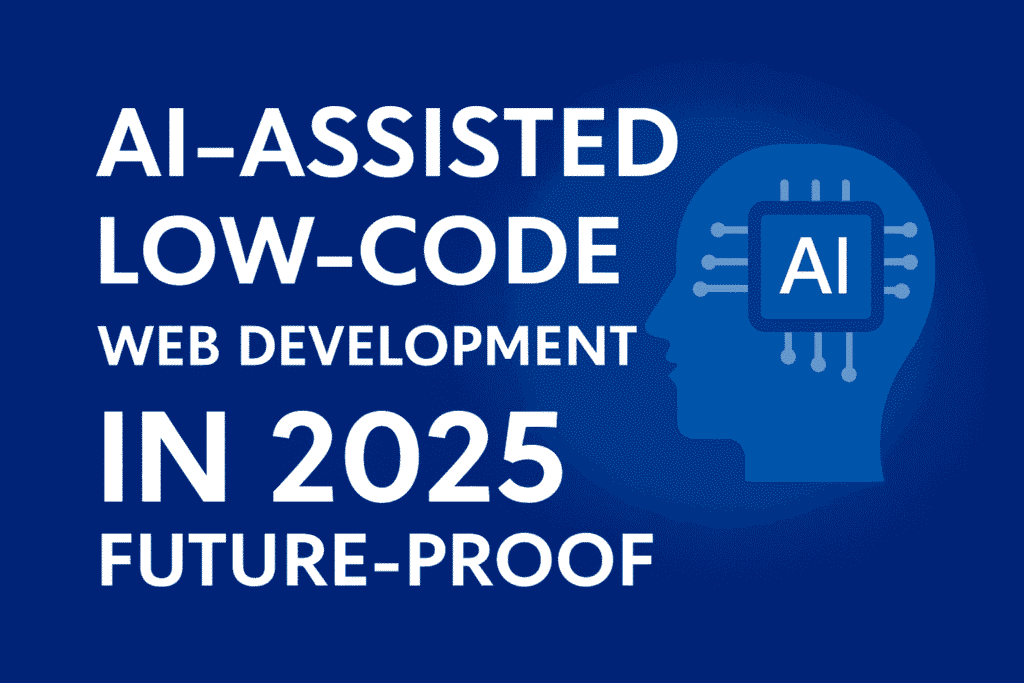
AI-Assisted Low-Code Web Development 2025 is transforming how small businesses build apps. Unlike traditional coding, this approach…. Businesses that want to stay relevant in 2025 can no longer rely on static websites or outdated frameworks. Instead, they need scalable, secure, and user-friendly web applications. This is where AI-Assisted Low-Code Web Development comes in.
Unlike traditional coding, where every feature must be built from scratch, low-code platforms let developers and businesses create apps quickly with drag-and-drop interfaces, pre-built modules, and seamless integrations. When combined with AI-powered tools — like GitHub Copilot, ChatGPT, and automated testing frameworks — development becomes faster, smarter, and more efficient.
For small businesses, this shift is a game-changer. It means lower development costs, faster go-to-market timelines, and apps optimized for SEO and performance. In this blog, we’ll explore why AI-assisted low-code web development is trending in 2025, its benefits, best practices, costs, and how your business can get started.
How Small Businesses Use AI-Assisted Low-Code Web Development in 2025
Web development is no longer just about building websites it’s about creating digital ecosystems. In 2025, five trends are driving the adoption of AI-assisted low-code platforms:
- AI Integration Everywhere
From content generation to debugging code, AI tools now support developers in reducing repetitive tasks and delivering higher-quality output. - Core Web Vitals 2.0
In 2025, meeting Google’s Core Web Vitals 2.0 is essential for SEO success, as faster, more responsive apps directly improve rankings. Meeting these metrics requires optimization that AI-assisted frameworks excel at. https://developers.google.com/web/vitals? - Small Business Digital Transformation
Small businesses are seeking affordable solutions to compete with large enterprises. Low-code tools reduce costs without compromising quality. - Rise of Progressive Web Apps (PWAs)
Businesses want apps that feel like mobile apps but run in browsers. Low-code + AI makes PWAs easier to build and optimize. - Microservices & Serverless Architectures
Modern apps must be modular and scalable. AI-assisted frameworks simplify integration with microservices, APIs, and cloud-native systems.
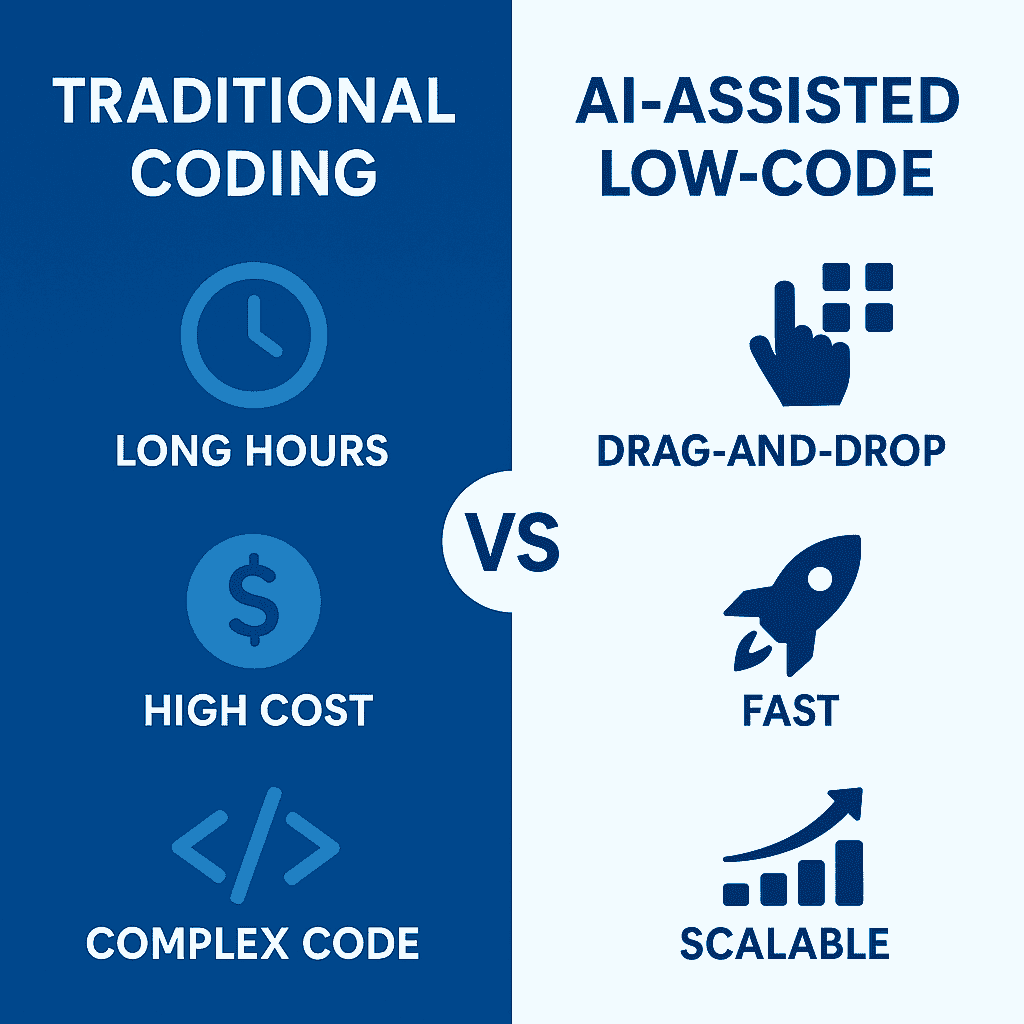
Benefits of AI-Assisted Low-Code Web Development 2025
Small businesses face challenges like limited budgets, fewer resources, and tight deadlines. Here’s how AI-assisted low-code solutions solve those pain points:
- Speed to Market: Launch apps 3–5x faster than traditional development.
- Cost-Efficiency: Save up to 60% on initial development and maintenance costs.
- Scalability: Apps are future-proof and grow as your business grows.
- SEO Optimization: Built-in features ensure better rankings with fast-loading, mobile-friendly apps.
- Reduced Technical Debt: Pre-tested components and AI-optimized code minimize bugs.
- Accessibility: Non-technical team members can collaborate in app design, thanks to drag-and-drop tools.
Emerging Trends in Web Development for 2025
To stay competitive, businesses must align with trends shaping the industry:
1. AI-Powered Development Tools
From GitHub Copilot writing boilerplate code to AI chatbots that integrate seamlessly, AI is no longer optional — it’s essential.
2. Low-Code & No-Code Platforms
Tools like Bubble, OutSystems, and Mendix allow businesses to create prototypes or MVPs quickly. Combined with custom coding, they balance flexibility and speed.
3. Progressive Web Apps (PWAs)
PWAs load instantly, even offline, and provide mobile-like experiences. Google rewards them with higher rankings due to fast performance.
4. Serverless & Microservices Architectures
Instead of relying on bulky monolith apps, businesses can deploy modular microservices that scale efficiently.
5. Cloud-Native Deployment
AWS, GCP, and Azure make hosting, scaling, and securing apps easier than ever.
6. Voice Search & Structured Data
With 50%+ of searches being voice-based in 2025, businesses must optimize apps with schema and natural language queries.
Cost of AI-Assisted Low-Code Web Development
The cost of building a custom web application in 2025 depends on scope, complexity, and technology stack:
- Basic MVP or Portal: $8,000 – $15,000
- Mid-level Business App with Integrations: $20,000 – $40,000
- Enterprise-Grade Scalable Platform: $50,000+
Factors influencing costs:
- Number of features (basic vs. AI-driven analytics).
- Tech stack (MERN, Next.js, Flutter Web).
- Deployment (cloud hosting, CDNs, security).
- Integrations with third-party tools (CRM, ERP, payment gateways).
How to Implement AI-Assisted Low-Code Web Development
Here’s a simple roadmap:
- Define Goals & Audience
Understand your target users and business goals. - Choose a Tech Stack
MERN, MEAN, or low-code platforms (Bubble, OutSystems). - Integrate AI Tools
Use AI for coding, UI design, analytics, and content generation. - Optimize for SEO
Use keyword-optimized URLs, meta descriptions, and schema markup. - Performance & Testing
Ensure apps meet Core Web Vitals 2.0. Test for speed, security, and responsiveness. - Launch & Monitor
Deploy on AWS/GCP/Azure. Use AI-powered analytics to track performance.
Case Study Example
Imagine a small eCommerce brand selling organic skincare products. With limited funds, they wanted an app that works like Shopify but custom to their needs.
- Using AI-assisted low-code tools, they launched in 8 weeks.
- Integrated voice search and PWA features.
- Optimized for Core Web Vitals, improving SEO rankings.
- Cost: ~$12,000 (vs. $40k traditional build).
- Result: 35% higher engagement and 50% faster checkout times.
SEO Checklist for 2025
- – Optimized permalink & meta description
- – Keyword density (2–3% for long-tail phrases)
- – H1, H2, H3 structure with keywords
- – Image alt tags with descriptive keywords
- – Internal linking (services, case studies, contact)
- – Schema markup for FAQs and articles
- – Core Web Vitals 2.0 compliance
- – Voice search optimization
FAQs on AI-Assisted Low-Code Web Development in 2025
Q1. What is AI-assisted web development?
AI-assisted development uses tools like GitHub Copilot and ChatGPT to speed up coding, testing, and optimization while maintaining human oversight.
Q2. Why should small businesses use low-code platforms?
They reduce costs, speed up launches, and provide scalable, SEO-ready apps.
Q3. How do PWAs help in SEO?
PWAs improve load times and user experience, which directly improves Google rankings.
Q4. Can AI replace developers?
No. AI supports developers by automating tasks, but human expertise is still essential for logic, creativity, and security.
Q5. What’s the average cost?
Anywhere from $8,000 to $50,000+ depending on complexity and features.
Q6. Is low-code secure?
Yes — when paired with API security, encryption, and RBAC, low-code apps meet enterprise standards.
Q7. Which industries benefit most?
eCommerce, healthcare, fintech, logistics, and education.
Conclusion
Many businesses are also adopting low-code platforms like OutSystems to speed up delivery while keeping costs low. In 2025, small businesses no longer need to choose between speed and quality — they can have both. By leveraging AI, low-code platforms, and scalable cloud solutions, businesses can build apps that rank well, perform smoothly, and engage customers effectively.
At LogicNosh, our Web Development Services are designed to blend AI-assisted low-code frameworks with scalable, cloud-native architectures. Whether you need a custom PWA, AI-driven dashboard, or scalable SaaS product, our team delivers solutions that combine innovation with SEO best practices.
👉 Contact us today to discuss your project and see how we can help your business grow with AI-Assisted Low-Code Web Development 2025.

